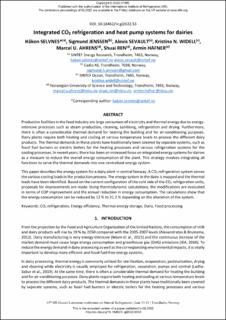| dc.contributor.author | Selvnes, Håkon | |
| dc.contributor.author | Jenssen, Sigmund | |
| dc.contributor.author | Sevault, Alexis | |
| dc.contributor.author | Widell, Kristina Norne | |
| dc.contributor.author | Ahrens, Marcel Ulrich | |
| dc.contributor.author | Ren, Shuai | |
| dc.contributor.author | Hafner, Armin | |
| dc.date.accessioned | 2022-11-03T09:40:54Z | |
| dc.date.available | 2022-11-03T09:40:54Z | |
| dc.date.created | 2022-10-13T14:09:08Z | |
| dc.date.issued | 2022 | |
| dc.identifier.citation | 15th IIR-Gustav Lorentzen Conference on Natural Refrigerants - GL2022 - Proceedings - Trondheim, Norway, June 13-15th 2022 | en_US |
| dc.identifier.isbn | 978-2-36215-045-6 | |
| dc.identifier.issn | 0151-1637 | |
| dc.identifier.uri | https://hdl.handle.net/11250/3029785 | |
| dc.description.abstract | Production facilities in the food industry are large consumers of electricity and thermal energy due to energyintensive processes such as steam production, cleaning, sanitising, refrigeration and drying. Furthermore, there is often a considerable thermal demand for heating the building and for air‐conditioning purposes. Dairy plants require both heating and cooling at various temperature levels to process the different dairy products. The thermal demands in these plants have traditionally been covered by separate systems, such as fossil fuel burners or electric boilers for the heating processes and various refrigeration systems for the cooling processes. In recent years, there has been an increased focus on integrated energy systems for dairies as a measure to reduce the overall energy consumption of the plant. This strategy involves integrating all functions to serve the thermal demands into one centralised energy system. This paper describes the energy system for a dairy plant in central Norway. A CO2 refrigeration system serves the various cooling loads in the production process. The energy system in the dairy is mapped and the thermal loads have been identified. Based on the current configuration of the cold side of the CO2 refrigeration units, proposals for improvements are made. Using thermodynamic calculations, the modifications are evaluated in terms of COP improvement and the annual reduction in energy consumption. The calculations show that the energy consumption can be reduced by 12 % to 21.2 % depending on the alteration of the system. | en_US |
| dc.description.abstract | Integrated CO2 refrigeration and heat pump systems for dairies | en_US |
| dc.language.iso | eng | en_US |
| dc.publisher | IIR | en_US |
| dc.relation.ispartof | 15th IIR-Gustav Lorentzen Conference on Natural Refrigerants - GL2022 - Proceedings - Trondheim, Norway, June 13-15th 2022 | |
| dc.relation.ispartofseries | Science et technique du froid; | |
| dc.title | Integrated CO2 refrigeration and heat pump systems for dairies | en_US |
| dc.title.alternative | Integrated CO2 refrigeration and heat pump systems for dairies | en_US |
| dc.type | Chapter | en_US |
| dc.type | Peer reviewed | en_US |
| dc.description.version | acceptedVersion | en_US |
| dc.rights.holder | IIR | en_US |
| dc.source.pagenumber | 1364-1373 | en_US |
| dc.identifier.cristin | 2061215 | |
| dc.relation.project | EC/H2020/101036588 | en_US |
| dc.relation.project | Norges forskningsråd: 308847 | en_US |
| dc.source.articlenumber | 0053 | en_US |
| cristin.ispublished | true | |
| cristin.fulltext | postprint | |
| cristin.qualitycode | 1 | |
